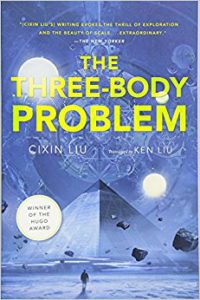 The Three-Body Problem is a Hugo-Award-winner and SF best seller that demanded to be read, but my first try was unsuccessful. I lost interest after a hundred pages. A month later I gave it another try and finished and I’m glad I did. My conclusion is that the novel has some attractive ideas if you put in the effort.
The Three-Body Problem is a Hugo-Award-winner and SF best seller that demanded to be read, but my first try was unsuccessful. I lost interest after a hundred pages. A month later I gave it another try and finished and I’m glad I did. My conclusion is that the novel has some attractive ideas if you put in the effort.
The first part turned out to be the most interesting, as it was set during the Chinese Cultural Revolution of the 1960’s-70’s and provided a view into life under that upheaval. What would it be like to live in a world where interpersonal, political and economic decisions were arbitrary, unpredictable, and designed to crush the human spirit? How can a person live in such chaos?
By loose analogy, the three-body problem in classical mechanics is also a chaotic system. It’s a problem of gravitational interaction where three objects, such as the sun, the earth, and the moon, are moving in each others’ fields. The movements are so unpredictable that it was identified as an unsolvable problem as early as the 1740’s. With today’s supercomputers, we can get approximations to a solution that are good enough to control spacecraft that use gravitational slingshots for propulsion.
In the novel, characters in the modern period are fond of a video game in which they explore an imaginary planet, Trisolaris, that has three suns, which creates a four-body problem. I don’t know why the author didn’t decide on two suns, making it a three-body body problem, since that is the title of the book. Maybe the mass of the planet was negligible.
In any case, life on Trisolaris is unpredictable, with periods of extreme heat and extreme cold, as the unpredictable suns move around each other. The analogy to experience of the Cultural Revolution is there to be mined by some scholar, but it is, inexplicably, not well-drawn out by the author.
After 167 pages of throat-clearing, the author suddenly gets to the crux of the story, a SETI project that receives a message from another star system. The first third of the book is then forgotten and wasted, a real shame. Either the story should have started with the SETI investigation, or the implications of the Cultural Revolution should have carried strongly forward into it. Instead, there is a discontinuity, as there was in Chinese history.
The extraterrestrial civilization contacted is none other than Trisolaris, a real star system uncannily similar to the video game everybody has been playing. Coincidence? I won’t tell.
The last third of the book is likewise a discontinuous new story, only loosely connected to the rest of the book. The SETI search is over and now it’s cat-and-mouse with the Trisolarians who are set to invade Earth. Some chapters are set on Trisolaris and involve vaguely sketched characters there.
Despite some efforts to stitch the book into a unit (a recurring character who gradually grows old throughout), it doesn’t hang. The interesting cultural flavor of the first third is lost in the last two-thirds, replaced by increasingly fantastical and implausible action for the sake of action in which the lives of the characters are submerged.
I never could relate to the characters, who seemed like wooden placeholders for announcing the author’s ideas. There was a tiny hint in the beginning of a love triangle that could have been a sly analogy to the three-body problem but that didn’t pan out either.
So in the end I am left with admiration for the author’s fertile imagination, but not for his storytelling, and I’m pretty sure the book will not remain long in collective memory. It counts as “hard” sci-fi, since it stays close to real or slightly exaggerated science, but it doesn’t really count as psi-fi, since it does not explore, in any serious way, the effects of science and technology on human psychology. Nevertheless, I give it points for trying to show how cultural history can be affected by science and technology. Sci-Hi-Fi?
Liu, Cixin (2014). The Three Body Problem (Ken Liu, trans.). New York: Tor, 390 pp.